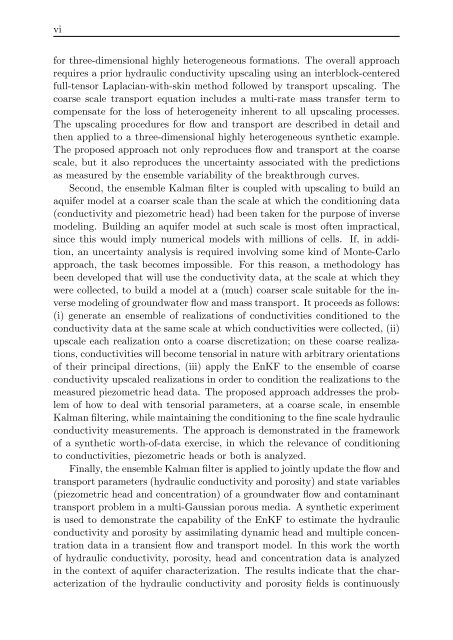Upscaling and Inverse Modeling of Groundwater Flow and Mass ...
Upscaling and Inverse Modeling of Groundwater Flow and Mass ...
Upscaling and Inverse Modeling of Groundwater Flow and Mass ...
Create successful ePaper yourself
Turn your PDF publications into a flip-book with our unique Google optimized e-Paper software.
vi<br />
for three-dimensional highly heterogeneous formations. The overall approach<br />
requires a prior hydraulic conductivity upscaling using an interblock-centered<br />
full-tensor Laplacian-with-skin method followed by transport upscaling. The<br />
coarse scale transport equation includes a multi-rate mass transfer term to<br />
compensate for the loss <strong>of</strong> heterogeneity inherent to all upscaling processes.<br />
The upscaling procedures for flow <strong>and</strong> transport are described in detail <strong>and</strong><br />
then applied to a three-dimensional highly heterogeneous synthetic example.<br />
The proposed approach not only reproduces flow <strong>and</strong> transport at the coarse<br />
scale, but it also reproduces the uncertainty associated with the predictions<br />
as measured by the ensemble variability <strong>of</strong> the breakthrough curves.<br />
Second, the ensemble Kalman filter is coupled with upscaling to build an<br />
aquifer model at a coarser scale than the scale at which the conditioning data<br />
(conductivity <strong>and</strong> piezometric head) had been taken for the purpose <strong>of</strong> inverse<br />
modeling. Building an aquifer model at such scale is most <strong>of</strong>ten impractical,<br />
since this would imply numerical models with millions <strong>of</strong> cells. If, in addition,<br />
an uncertainty analysis is required involving some kind <strong>of</strong> Monte-Carlo<br />
approach, the task becomes impossible. For this reason, a methodology has<br />
been developed that will use the conductivity data, at the scale at which they<br />
were collected, to build a model at a (much) coarser scale suitable for the inverse<br />
modeling <strong>of</strong> groundwater flow <strong>and</strong> mass transport. It proceeds as follows:<br />
(i) generate an ensemble <strong>of</strong> realizations <strong>of</strong> conductivities conditioned to the<br />
conductivity data at the same scale at which conductivities were collected, (ii)<br />
upscale each realization onto a coarse discretization; on these coarse realizations,<br />
conductivities will become tensorial in nature with arbitrary orientations<br />
<strong>of</strong> their principal directions, (iii) apply the EnKF to the ensemble <strong>of</strong> coarse<br />
conductivity upscaled realizations in order to condition the realizations to the<br />
measured piezometric head data. The proposed approach addresses the problem<br />
<strong>of</strong> how to deal with tensorial parameters, at a coarse scale, in ensemble<br />
Kalman filtering, while maintaining the conditioning to the fine scale hydraulic<br />
conductivity measurements. The approach is demonstrated in the framework<br />
<strong>of</strong> a synthetic worth-<strong>of</strong>-data exercise, in which the relevance <strong>of</strong> conditioning<br />
to conductivities, piezometric heads or both is analyzed.<br />
Finally, the ensemble Kalman filter is applied to jointly update the flow <strong>and</strong><br />
transport parameters (hydraulic conductivity <strong>and</strong> porosity) <strong>and</strong> state variables<br />
(piezometric head <strong>and</strong> concentration) <strong>of</strong> a groundwater flow <strong>and</strong> contaminant<br />
transport problem in a multi-Gaussian porous media. A synthetic experiment<br />
is used to demonstrate the capability <strong>of</strong> the EnKF to estimate the hydraulic<br />
conductivity <strong>and</strong> porosity by assimilating dynamic head <strong>and</strong> multiple concentration<br />
data in a transient flow <strong>and</strong> transport model. In this work the worth<br />
<strong>of</strong> hydraulic conductivity, porosity, head <strong>and</strong> concentration data is analyzed<br />
in the context <strong>of</strong> aquifer characterization. The results indicate that the characterization<br />
<strong>of</strong> the hydraulic conductivity <strong>and</strong> porosity fields is continuously


